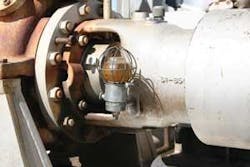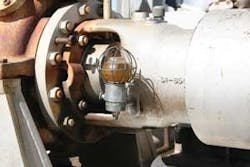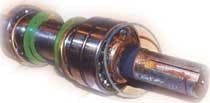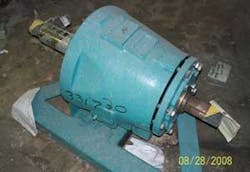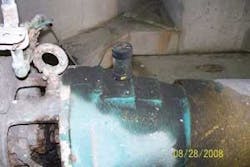Lube – Too Much of a Good Thing?
by Robert L. Matthews
How many lube level-caused failures are from too little lube or too much? I don't have a survey, but what I see as a pump systems reliability specialist is most failures are due to too much lube. This causes bearing failures more than not enough lube by far. Consider that motors ranging from ¼ hp to 7½ hp are to be greased once every 10 years in easy service, once every seven in standard service, once every four in severe service, and once every nine months in very severe service. This is common information in the industrial lubrication field. Now, ask a lube tech how often he lubes his motors. I did this today in a large refinery and the techs said their foreman said to grease all equipment every two weeks.
There are times to adapt. Raised on a rice farm/cattle ranch near Anahuac, TX, I had to be adaptable as the spring rains would shut down ground plowing, forcing us to remove the rubber tires and put on lugged steel wheels. We flooded the fields with about 6"-8" of water, then packed the front wheel bearings with a water-repelling grease called Lubriplate. This gave a whole new approach to mud bath. And, if a water moccasin or cotton mouth was spaded or caught by a wheel lug, the snake came striking at you as the wheel brought it around the tractor fender. That will get your attention. We jacked up the tractor front end every morning and each day at noon and packed the bearings when water plowing and purged the implement bearings. Here, too much grease wasn't an issue and too little was what my Dad better not have seen.
How much lube is appropriate?
- In an oil bath housing, the oil level is to be halfway up the lowest ball in a ball bearing.
- In a oil slinger application, 1/8 to ¼ inch up on the inside of the ring.
- In a gear box with spur gears, herringbone gears etc. cover at least two gear teeth.
- In a worm gear box, cover half the worm shaft with oil.
- In a lubricated coupling, 25% or so area is to be free of grease for movement.
- In a pillow block bearing, hand pack the bearing and fill the housing 1/3 full.
These generic rules help, but always check the manufactures recommendation! Always check compatibility with grease and maintain viscosity and other specs with oils. Too much lube can be poured directly in the nip point of two meshing gears that only need a film of oil. A film of oil is what most lubrication is all about.
The good intention of employees adding oil to the oil bowl lubricator has caused many overfills. The oil bowl sets in a metal cup with an oil setting but the cup is filled to its top, this puts way too much oil in the bearing housing causing heat, overloading conditions to the oil, and driver energy demand increase. The oil bowl is designed to add oil as the set oil level is reduced – and, as air enters the bowl, oil is dropped in the bearing housing.
The greased coupling is one item that's abused all the time with too much grease. These couplings come with a prescribed amount of grease that covers the gear teeth or the grid. This is hand packed and allows adequate lubrication that's contained by a split shroud with two fittings on most of these and pipe plugs in them. One of the plugs is sometimes replaced with a grease fitting and grease is pumped in this can over pressure the shroud and add thrust to the motor bearings or blow out the seals depending on how much. When pumping in grease, the fill amount is unknown and mixing new grease with old doesn't necessarily produce good grease. Couplings should have a scheduled maintenance to remove old grease, inspect coupling components, and lubricate with the correct grease and the right amount. But still most techs will remove both plugs and add a fitting, then pump grease through the coupling and plug the shroud.
Here's where you can't put too much oil to hurt the equipment. When preserving equipment, spares, etc., you need protective oils called vapor phase which puts a cloud like mist in the air of the bearing housings. Only about 10% fill in the housing is needed; but, most of the time, the housings are filled to the top and it is drained down to 10%. If these housings are sealed, the oil lasts for a long time and is sometimes used in again in another piece of equipment.
The one overlooked oil that protects our pumps and other equipment is assembly lube. Assembly lube has saved so much equipment. It protects the bearings from rust, it reduces the chance of bearing shock damage and it aids in smooth start-ups. This was my first introduction to Royal Purple – my current employer. We put its Max-Tuff® assembly lube in the pumps at a Champion International paper mill in Sheldon, TX. The protection gained fame because one pump in the power house was started without any oil and ran on the assembly lube for over two weeks. Shortly before three weeks, it was found out and oil was added on the run. Out of curiosity months later, the pump was pulled to inspect the bearing and it showed a mirrored polish where the assembly lube supported the bearings.
Put in the correct amount of lube. And, if you aren't sure, read the manufacturer's instructions. Always take the time to do it right at the start and the paybacks are generous.
About the Author: Reliability manager for Houston-based Royal Purple Ltd., Bob Matthews has 35+ years of pump industry experience – from hands-on to supervision, in-plant maintenance management, consulting and training. He has taught advanced pump classes for Fortune 500 companies, universities, the Vibration Institute, ASME and FSA. Contact: www.royal-purple.net